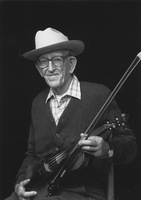 | Back to e-WV
| Back to e-WV
 The West Virginia Encyclopedia
The West Virginia Encyclopedia
 | Back to e-WV
| Back to e-WV
 The West Virginia Encyclopedia
The West Virginia Encyclopedia

Old-time music is music from the home and community. Much of this music predates recordings. It consists of traditional instrumental fiddle tunes from the Old World, such as ‘‘Soldier’s Joy,’’ and Old World ballads such as ‘‘Barbara Allen.’’ It also includes original American ballads, based on real events, such as ‘‘John Henry,’’ and popular music and poems that passed into oral tradition.
Folklorists, including John Harrington Cox, Louis W. Chappell, and Patrick Gainer, had been documenting and later recording West Virginia music since World War I, but many Mountain State musicians first came to widespread attention during the folk revival of the 1960s and 1970s. Through commercial recordings and increasingly popular festivals, they reached a broad audience. This group included, among others, the Roane County fiddler Frank George; Burl, Sherman, Maggie, and Edden Hammons of Pocahontas County; Putnam County banjo player Elmer Bird; Ernie Carpenter and Melvin Wine from Braxton County; fiddler Emery Bailey of Calhoun County; Wirt County fiddler Glen Smith; Kanawha County fiddle legend Clark Kessinger; and Clay County musicians French Carpenter, Wilson Douglas, Doc White, Ira Mullins, Lee Triplett, John Morris, Jenes Cottrell, and Sylvia O’Brien. Most of them were gone by the year 2000, but they have left their music in the hands of a large generation of musicians who learned from them.
Old-time music is not the same as bluegrass, which is much younger. Whereas old-time music is generally limited to fiddle, guitar, and banjo, bluegrass often adds mandolin, bass, and dobro. Bluegrass is often played faster, and the various instruments take solo ‘‘breaks,’’ whereas normally in old-time music all instruments play all the time. Much old-time music has a purpose other than just its sound. The fiddle tunes are for dancing. The ballads commemorate events. Bluegrass is performance music, developed from the first for a commercial audience, whereas old-time musicians often sit in a circle and play to one another. Both genres are traditional, but old-time musicians seek to retain the traditional form, while bluegrass music continually evolves without such a strict commitment to established tradition. Bluegrass draws on blues, fiddle tunes, old-time country music, and gospel harmony. The fiddle is sometimes tuned differently, and the bowing is very different. There is more emphasis on tight vocal harmonies.
Traditionally, the old-time music lived in homes, farms, timber camps, or coal towns and was part of lives filled with hard work. Elmer Bird remembered his father playing music to relax after a day in the fields. In Braxton County, Smithy Wine’s tunes lived into the 21st century through his great-grandson, Melvin, who caught them from his father, fiddler Bob Wine. They had been passed on from Bob’s father, Nels, who sang the tunes as he learned them from Smithy. A regular every year at the West Virginia Folk Festival in Glenville before he died in 2003 at age 93, Melvin passed his tunes on to his son, Grafton, his friend Gerry Milnes, and others. And so the music has been carried on, from father to son, or grandfather to grandson, singer to singer, and fiddler to fiddler. It is a living tradition.
Written by Paul Gartner
Conway, Cecelia. African Banjo Echoes in Appalachia: A Study of Folk Traditions. Knoxville: University of Tennessee, 1995.
Milnes, Gerald. Play of a Fiddle. Lexington: University Press of Kentucky, 1999.
Boette, Marie. Singa Hipsy Doodle and other Folk Songs of West Virginia. Parsons: McClain, 1971.